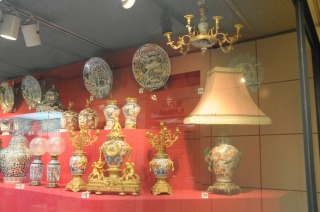Japanese pottery (Arita porcelain ware)ŃĆĆüEüE/h2>
(Pontinued from previous)
The location near China and Korea having a high level of quality porcelain productions was a big advantage for Arita.
After many experiments referring to Chinese style patterns, they gradually started to arrange for a Japanese style establishment which can be seen in white and blue colored porcelain today.
In addition, "Aote" (which covered whole pottery in green, yellow, and blue), and "kakiemon style" (which carried out china-painting employing unfilled milky-white space efficiently by basically using red) were produced. These are based on the unique aesthetic sense of Japan.

Imari early works.
Arita energetically created high quality and impressive works one after another at this time like the magic of many nations' flags coming out from a silk hat. These attracted Feudal lords called Damiyo and court nobles called Kuge, and their many orders, therefore domestic demands increased sharply.

Aote (the right one)

Kakiemon style
Finally the period of Arita peaked while Jingdezhen, which is one of the top Chinese porcelain famous cities, temporary stopped their export for their government's disturbance. Arita gathered great reputations and took the place of Jingdezhen.
Let's just look at the history of Japan. It was under the national isolationism called Sakoku in the middle of the 17th century. Any diplomacy activities and international trades were strictly limited. You may wonder why many porcelain productions were exported in such a situation?
The answer is "Dejima". It was a small fan-shaped artificial island built in the bay of Nagasaki, and the only ward specially allowed to trade with foreign merchants from China and Holland only.
Arita is about in 70 kilometers away from Dejima in a straight line. Arita porcelain was exported to Europe as IMARI WARE named after the Imari port.
Arita artists roused themselves more to meet European expectations hoping for more gorgeous and bigger porcelain wares in order to decorate royal places in the style of Baroque and Rococo. They created large platters and large lid-crocks, and even chandelier covers in response to European demands. Gold-painted porcelain called Kinrante is often seen in Imari porcelain from this period. A lot of elegant Imari porcelain was endlessly exported one after another.

Kinrante

Kinrante
This is what happened within 100 years ŌĆüEvery rapid technical innovation and potter's unending challenge-spirits pulled the porcelain industry up to the world level.
Arita is thought to be continuously stimulated from overseas to obtain their techniques and established channels of distribution. Yi Sam-pyeong was originally from the Korean Peninsula, and Zheng Chenggong brought glazing techniques from China. Trade itself was under the East India Company by the Holland. Arita was the professional group with a high level of techniques and never-give-up-spirit in response foreign demands.
Even today there is a company which has revolutionarily done its technical innovations by the stimulus from outside ŌĆüEApple Inc. They newly developed the technology of Xerox Co. and Microsoft Co. after persuading one of designers who had worked on an advertisement for Intel Co., and a president of Pepci-Cola Co. Apple and Arita may have something in common such as strong creativity and tough craftsmanship at the bottom of their hearts.
